|
The Alice Paul Memorial March,
Washington, D.C. 1977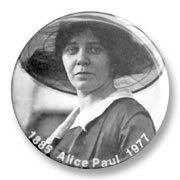
Browse photos of the Alice Paul Memorial March.
 On
August 26, 1977 four thousand people marched up Pennsylvania Avenue in
memory of Alice Paul, who had died on July 9. Paul was the leader of the
militant wing of the U.S. Suffrage movement, the author and chief promoter
of the Equal Rights Amendment, and an activist who encouraged the spread
of feminist ideas all over the world. On
August 26, 1977 four thousand people marched up Pennsylvania Avenue in
memory of Alice Paul, who had died on July 9. Paul was the leader of the
militant wing of the U.S. Suffrage movement, the author and chief promoter
of the Equal Rights Amendment, and an activist who encouraged the spread
of feminist ideas all over the world.
 Born on January 11, 1885 in New Jersey, Paul went to England in 1906 to
do settlement work soon after graduating from Swarthmore College. There
she became involved in the Women's Social and Political Union (WSPU) --
the British Suffrage militants -- from whom she learned how to gain publicity
for the cause through mass marches, demonstrations, drastic actions and
arrests. After returning to the States to complete her Ph.D. in Political
Science at the University of Pennsylvania, she persuaded the National
American Woman Suffrage Association (NAWSA) to revive its Congressional
Committee in order to lobby for a federal amendment.
Born on January 11, 1885 in New Jersey, Paul went to England in 1906 to
do settlement work soon after graduating from Swarthmore College. There
she became involved in the Women's Social and Political Union (WSPU) --
the British Suffrage militants -- from whom she learned how to gain publicity
for the cause through mass marches, demonstrations, drastic actions and
arrests. After returning to the States to complete her Ph.D. in Political
Science at the University of Pennsylvania, she persuaded the National
American Woman Suffrage Association (NAWSA) to revive its Congressional
Committee in order to lobby for a federal amendment.
 On March 3, 1913, Paul organized a Suffrage parade of 8,000 women to march
up Pennsylvania Avenue. Inez Milholland rode at the front on a white horse.
As it was the eve of the inauguration of the new President, Woodrow Wilson,
Washington was full of visitors. Jeering bystanders spat on and assaulted
the marchers and blocked their way. The resulting publicity focused the
country's attention on Woman Suffrage.
On March 3, 1913, Paul organized a Suffrage parade of 8,000 women to march
up Pennsylvania Avenue. Inez Milholland rode at the front on a white horse.
As it was the eve of the inauguration of the new President, Woodrow Wilson,
Washington was full of visitors. Jeering bystanders spat on and assaulted
the marchers and blocked their way. The resulting publicity focused the
country's attention on Woman Suffrage.
 A month later, Paul founded the Congressional Union for Woman Suffrage
with her colleague Lucy Burns. This became her base of operations after
NAWSA removed her from its Committee. The women who joined the CU reflected
a generational split in the Suffrage movement. The younger women were
more likely to be college educated, to want jobs and careers, and to find
militant action attractive than the older war horses of NAWSA.
A month later, Paul founded the Congressional Union for Woman Suffrage
with her colleague Lucy Burns. This became her base of operations after
NAWSA removed her from its Committee. The women who joined the CU reflected
a generational split in the Suffrage movement. The younger women were
more likely to be college educated, to want jobs and careers, and to find
militant action attractive than the older war horses of NAWSA.
 In June of 1916 they founded the National Woman's Party (NWP), choosing
Anne Martin of Nevada to head it. Martin was another young woman who had
served an apprenticeship with the British suffrage movement. The Congressional
Union soon merged with the NWP. While Alice Paul was not always the NWP's
official leader, she was always its guiding light.
In June of 1916 they founded the National Woman's Party (NWP), choosing
Anne Martin of Nevada to head it. Martin was another young woman who had
served an apprenticeship with the British suffrage movement. The Congressional
Union soon merged with the NWP. While Alice Paul was not always the NWP's
official leader, she was always its guiding light.
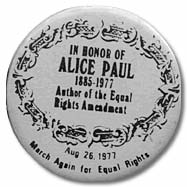
 The NWP adopted the WSPU strategy of opposing the party in power to punish
it for not passing a federal suffrage amendment. Since the Democrats controlled
the federal government at that time, the NWP systematically campaigned
against all Democrats running for office in the twelve states where women
could vote for President, regardless of their personal position on Woman
Suffrage. In June 1920, with one state left to ratify the 19th Amendment,
the NWP picketed the Republican convention and threatened to follow that
party on the campaign trail with pickets, hecklers and embarrassing questions.
The NWP adopted the WSPU strategy of opposing the party in power to punish
it for not passing a federal suffrage amendment. Since the Democrats controlled
the federal government at that time, the NWP systematically campaigned
against all Democrats running for office in the twelve states where women
could vote for President, regardless of their personal position on Woman
Suffrage. In June 1920, with one state left to ratify the 19th Amendment,
the NWP picketed the Republican convention and threatened to follow that
party on the campaign trail with pickets, hecklers and embarrassing questions.
 The Suffrage
amendment was officially declared part of the US Constitution on August
26, 1920. Fifty years later, the emerging women's liberation movement
commenced an annual celebration of that day as Suffrage Day. The 1977
march in Washington, D.C. was one of many feminist events held on August
26.
The Suffrage
amendment was officially declared part of the US Constitution on August
26, 1920. Fifty years later, the emerging women's liberation movement
commenced an annual celebration of that day as Suffrage Day. The 1977
march in Washington, D.C. was one of many feminist events held on August
26.
 Six months after the 19th Amendment was ratified, the NWP was refounded
and dedicated to the elimination of women's legal disabilities. Initially
it drafted model bills for states to pass. The NWP soon decided that this
strategy was too slow and uncertain. Paul oversaw the preparation of another
Constitutional amendment, which was announced at a major conference held
in Seneca Falls on July 21, 1923. Later that fall the
Equal Rights Amendment (ERA) was officially introduced into Congress
by Rep. Daniel R. Anthony (R. KS), nephew of Susan B., and the Senate
Republican Whip, Charles Curtis (R. KS), both of whom had been Suffrage
supporters.
Six months after the 19th Amendment was ratified, the NWP was refounded
and dedicated to the elimination of women's legal disabilities. Initially
it drafted model bills for states to pass. The NWP soon decided that this
strategy was too slow and uncertain. Paul oversaw the preparation of another
Constitutional amendment, which was announced at a major conference held
in Seneca Falls on July 21, 1923. Later that fall the
Equal Rights Amendment (ERA) was officially introduced into Congress
by Rep. Daniel R. Anthony (R. KS), nephew of Susan B., and the Senate
Republican Whip, Charles Curtis (R. KS), both of whom had been Suffrage
supporters.
 Pursuit of the ERA became Alice Paul's life work, but it was not all that
she did. She went to law school, and was awarded the LL.B. degree in 1922
and a doctorate in law in 1928. During the 1920s and the 1930s she often
lived abroad while working for women's equality all over the world. In
1938 she founded the World Woman's Party, which successfully lobbied for
the inclusion of equal rights for women in the United Nations Charter
in 1945. Under her leadership, the NWP lobbied for a prohibition of sex
discrimination in any bill or Executive Order prohibiting discrimination
on the basis of race, religion or national origin. Its one success was
the addition of "sex" to
Title VII of the 1964 Civil Rights Act, which prohibited discrimination
in employment.
Pursuit of the ERA became Alice Paul's life work, but it was not all that
she did. She went to law school, and was awarded the LL.B. degree in 1922
and a doctorate in law in 1928. During the 1920s and the 1930s she often
lived abroad while working for women's equality all over the world. In
1938 she founded the World Woman's Party, which successfully lobbied for
the inclusion of equal rights for women in the United Nations Charter
in 1945. Under her leadership, the NWP lobbied for a prohibition of sex
discrimination in any bill or Executive Order prohibiting discrimination
on the basis of race, religion or national origin. Its one success was
the addition of "sex" to
Title VII of the 1964 Civil Rights Act, which prohibited discrimination
in employment.
 In 1972 Congress passed the ERA and sent it to the states for ratification.
However, only 35 of the necessary 38 states ratified it by the deadline.
Paul died during the
campaign for ratification, which was led largely by the National Organization
for Women (NOW).
In 1972 Congress passed the ERA and sent it to the states for ratification.
However, only 35 of the necessary 38 states ratified it by the deadline.
Paul died during the
campaign for ratification, which was led largely by the National Organization
for Women (NOW).
 Soon thereafter Elizabeth Chittick, the current NWP President, decided
that the 1977 celebration of Suffrage Day should honor the NWP founder.
She asked NOW and other women's organization to join the NWP in a march
up Pennsylvania Avenue. The NWP also invited several original suffragists
to march with them. One of them, Hazel Hunkins Hallinan, came from London,
England at the age of 87 to symbolically link the major movements in Alice
Paul's life. She marched in the front line; several others rode on an
antique trolley further back.
Soon thereafter Elizabeth Chittick, the current NWP President, decided
that the 1977 celebration of Suffrage Day should honor the NWP founder.
She asked NOW and other women's organization to join the NWP in a march
up Pennsylvania Avenue. The NWP also invited several original suffragists
to march with them. One of them, Hazel Hunkins Hallinan, came from London,
England at the age of 87 to symbolically link the major movements in Alice
Paul's life. She marched in the front line; several others rode on an
antique trolley further back.

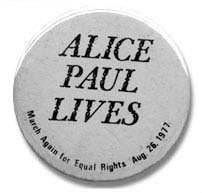 To replicate the drama and spectacle of the Suffrage parades, the NWP
asked everyone to wear traditional white. A young woman with horse was
found to replicate Inez Milholland's role, but the horse was a chestnut.
Many people also wore sashes of purple, white and gold; colors chosen
by the NWP to symbolize Woman Suffrage.The NPW explained that purple stood
for the "Royal glory of Womanhood"; white for "Purity in
the home and in Politics"; and gold for the "Crown of Victory".
Some people carried original Suffrage banners; some carried new ones made
for this march which identified their organizations and/or support for
the ERA.
To replicate the drama and spectacle of the Suffrage parades, the NWP
asked everyone to wear traditional white. A young woman with horse was
found to replicate Inez Milholland's role, but the horse was a chestnut.
Many people also wore sashes of purple, white and gold; colors chosen
by the NWP to symbolize Woman Suffrage.The NPW explained that purple stood
for the "Royal glory of Womanhood"; white for "Purity in
the home and in Politics"; and gold for the "Crown of Victory".
Some people carried original Suffrage banners; some carried new ones made
for this march which identified their organizations and/or support for
the ERA.
 However, the times had clearly changed. The 1913 parade was frequently
disrupted by unruly opponents until it ended with a mass meeting in the
Hall of the Daughters of the American Revolution. This march passed freely
up the street to a rally in Lafayette Square. In 1913 the police had refused
to protect the marchers from the crowd. In 1977, the police provided a
motorcycle escort. The purpose of the 1913 march was to make President
Wilson pay attention to Woman Suffrage. Personally opposed, he had said
nothing about it in the 1912 campaign even though other candidates and
their supporters spoke out on it. President Jimmy Carter was already on
record in support of the ERA. The morning of the march, he met with leaders
of 80 women's groups where he passed out pens used to sign a proclamation
designating August 26 as Women's Equality Day.
However, the times had clearly changed. The 1913 parade was frequently
disrupted by unruly opponents until it ended with a mass meeting in the
Hall of the Daughters of the American Revolution. This march passed freely
up the street to a rally in Lafayette Square. In 1913 the police had refused
to protect the marchers from the crowd. In 1977, the police provided a
motorcycle escort. The purpose of the 1913 march was to make President
Wilson pay attention to Woman Suffrage. Personally opposed, he had said
nothing about it in the 1912 campaign even though other candidates and
their supporters spoke out on it. President Jimmy Carter was already on
record in support of the ERA. The morning of the march, he met with leaders
of 80 women's groups where he passed out pens used to sign a proclamation
designating August 26 as Women's Equality Day.
 Wanting more than Carter's verbal support for the ERA, the women's groups
drew up a Petition to President Carter, which was carried throughout the
march. At the rally, it was presented to Midge Costanza, Carter's special
assistant for women's affairs, who had marched in the front line of the
march. It called on Carter "to exert the full political and moral
leadership of his office to help ratify the Equal Rights Amendment."
Costanza promised to deliver the message.
Wanting more than Carter's verbal support for the ERA, the women's groups
drew up a Petition to President Carter, which was carried throughout the
march. At the rally, it was presented to Midge Costanza, Carter's special
assistant for women's affairs, who had marched in the front line of the
march. It called on Carter "to exert the full political and moral
leadership of his office to help ratify the Equal Rights Amendment."
Costanza promised to deliver the message.

Photos of the 1977 Alice Paul Memorial
March by Jo Freeman
|
Please click on thumbnails to view the complete
image
|
|
|
|
The wording of the Equal Rights Amendment,
as passed by Congress in 1972
|
|
| |
|
|
|
|
Leading the march, from L to R: Bella Abzug,
Elizabeth Chittick, Hazel Hunkins Hallinan, Midge Costanza
|
|
| |
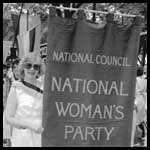
|
|
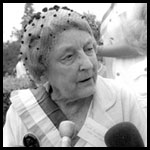 |
|
| . |
Mary Eastwood, Secretary of
the NWP, and a founder of NOW carries an original suffrage
banner
|
|
|
|
| . |
Hazel Hunkins Hallinan grew
up in Montana where she became state NWP chairman after it
was founded in 1916. She later picketed the White House demanding
Suffrage, for which she was arrested many times.
|
|
|
| |
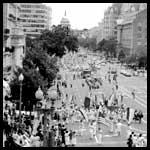 |
|
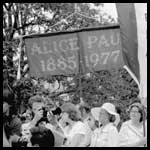 |
|
| |
The Capitol can be seen in the background
as marchers walk up Pennsylvania Avenue.
|
|
|
|
|
| |
|
Some of the many banners carried in the March
|
| |
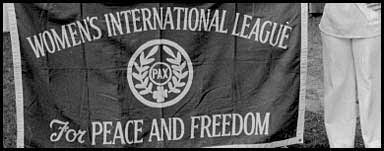 |
| |
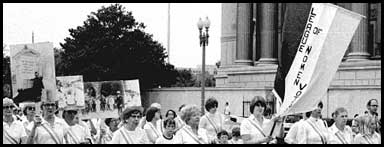 |
| |
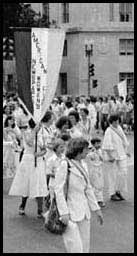 |
|
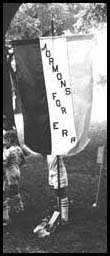 |
|
|
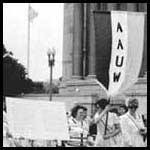 |
|
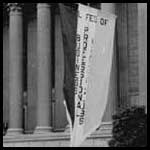 |
| |
|
Presenting the Petition to President Carter
|
|
|
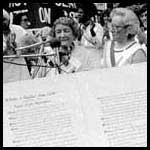
|
|
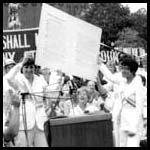 |
| |
Hazel Hunkins Hallinan and
Elizabeth Chittick.
|
|
|
|
| |
NOW President Ellie Smeal and
White House advisor Midge Costanza.
|
|
|
|
|
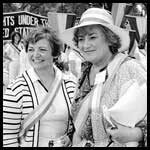 |
|
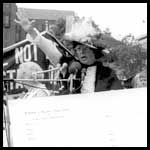 |
| |
New York Lt. Governor Mary
Anne Krupsak and former New York Congresswoman Bella Abzug,
are among the many congregating on the Mall prior to the march.
|
|
|
|
| |
A participant dresses as a
suffragist to symbolically link the two movements.
|
|
|
| |
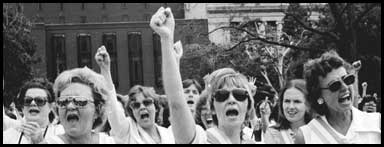 |
|
Enthusiastic support for the ERA.
|
| |
|
|
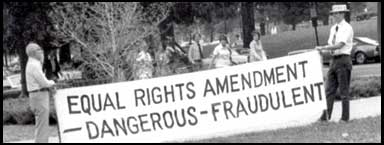 |
|
Not everyone agreed, but unlike 1913,
the few opponents at this march were restrained.
|
| |
|
|
| |
|
|